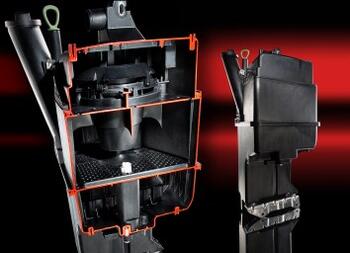First thermoplastic oil tank

At Chinaplas 2016 (Shanghai, April 25-28), Basf will exclusively co-host the “Design x Innovation” event in booth N1 B41, showcasing innovations that demonstrate the power of polymers to enable high-performance design in the areas of mobility, sports and leisure, as well as building and living.
One example is the world’s first thermoplastic oil tank for dry sump engines, developed by Hummel-Formen, a brand by ElringKlinger, at Lenningen, Germany. The reservoir, which weighs around 2.6 kg, is made from Ultramid A3WG7, a Basf polyamide 66 with 35% glass fibre reinforcement which is resistant to oil and thermal aging. The tank is therefore 59% lighter than previous steel or aluminium welding constructions and has an improved, multi-functional oil separation system which is integrated in the tank. The complex plastic component is used in the new Mercedes-AMG GT and is the second car that AMG has developed itself.
The material to match the oil reservoir is noted for its ingenious geometry. It comprises ten different, injection-moulded polyamide parts, which are joined together with 13 further elements like sensors, sieves, covers and screws to form one component. This is done by vibration welding and various snap-in mechanisms. By optimally using the available space, a lot of different functions could be integrated. Apart from the mere storage of the oil, the component deals with the ventilation of the crankcase including the oil separation, makes possible the filling and changing of the oil as well as controlling the oil level and its quality. Furthermore, it also slows down and roughly filters the incoming oil.
The Ultramid used shows high resistance to oil and corrosion, is thermally stable up to 180°C (for short periods even up to 240°C), and contributes to a favourable vibration and acoustic behaviour because of its high damping and stiffness. This means that the plastic oil tank is considerably quieter than metallic versions. The tried-and-tested PA66 also displays the rigidity required for this application and necessary to withstand the requested burst pressures.
As the Mercedes-AMG GT was developed for also driving the race track, it requires an appropriate lubrication solution, namely dry sump lubrication. In contrast to pressure lubrication, which is normally used in car engines and works with an oil pan, dry sump lubrication originates from motor racing. This is where the oil pan is replaced as oil reservoir by a separate tank, which has a tall and narrow design. The oil tank is configured so that the pressure oil pump is always able to reliably suck in the oil even in extreme driving situations, such as driving around bends at high speed or heavy braking.
In addition to product exhibits, the event “Design x Innovation” will feature industry expert discussions at open forums.

















